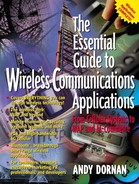The Air Link
The air link is the mobile equivalent of what telcos call the last mile or local loop—the final connection between the customer and the network.The name is somewhat misleading because it doesn't refer to every part of the network carried over air.Most operators have some base stations that are connected to the main network via high-bandwidth fixed wireless beams, and these aren't considered part of the air link.
For an air link to function, it requires two radios, one carried around by a user and one connected permanently to the operator's network. These are known to technicians as the MSU and BTS, though users will think of them as the mobile phone and base station.
MSU
The Mobile Subscriber Unit (MSU), or Mobile System (MS), is the name given by engineers to the terminal carried by users. For first- and second-generation systems this is usually a mobile phone, but other cellular devices exist and are expected to become more common. Most non-phone MSs in the twentieth century offered data only, from simple pagers to advanced Web and email devices, such as the Palm VII. But third-generation prototypes from companies such as Symbian promise true integrated voice and data, featuring two-way video and advanced computing functions. The future of phones and PDAs (Personal Digital Assistants) is discussed in more detail in Chapter 9, "Short-Range Wireless Networks."
BTS
Usually called the base station or cell site, the Base Transceiver Station (BTS) is the large radio at the center of every cell. Most BTSs consist of several antennas, usually placed inside white rectangular boxes measuring about 1 x 3 meters. They are usually placed high off the ground to prevent signals being blocked by buildings or trees. As well as the transceiver itself, a base station also needs to contain some kind of uplink to the mobile operator's network, which is usually a fiber-optic cable running through the ground or a fixed wireless transceiver. These are fully explained in Chapter 11, "Fixed Wireless Technology" Most also require a cooling system and heat sink, because the microwaves they generate could result in the transmitter overheating.
BTSs have become an increasingly common feature of the skyline in many towns, sprouting on rooftops, lampposts, and even church steeples. This has led to a backlash, with local residents worried both about aesthetic and health effects. As a result, mobile operators have begun to camouflage them by placing them inside everything from statues to flagpoles. One of the most popular disguises is the artificial tree, sold complete with refrigeration unit and redundant power supply.
The problem with concealing base stations in this way is that it makes them harder to avoid. Though there is still debate over the safety of cellphones themselves, BTSs are much stronger microwave sources and there is no doubt that they can be dangerous. Legends abound of military microwave installations in Alaska and Siberia, which gave away their positions by their tendency to boil snow over a wide area. Worse, cold warriors who tried to keep warm by standing in front of the transmitters reported a variety of health problems, including cancer and heart disease.
Both U.S. Federal and European Union regulations specify maximum exposure levels for microwave radiation, and mandate exclusion zones around BTSs which depend on their power. For example, a typical base station will require people to be about ten meters away. This doesn't cause a problem for a station on top of a large pole or a tree, but it might for one mounted on the roof of an apartment block. Such a setup requires extra shielding, though this isn't always enough to reassure the people living below.
If you are worried about cell sites, many phone companies or local planning departments will provide their locations. Failing that, some hobbyists like to drive or cycle round a city, using the signal strength indicator on their phone to determine when they are close to a site. On older phones, this can be made easier by removing the antenna from the handset, meaning that a signal will only be detected when very close to a base station.
